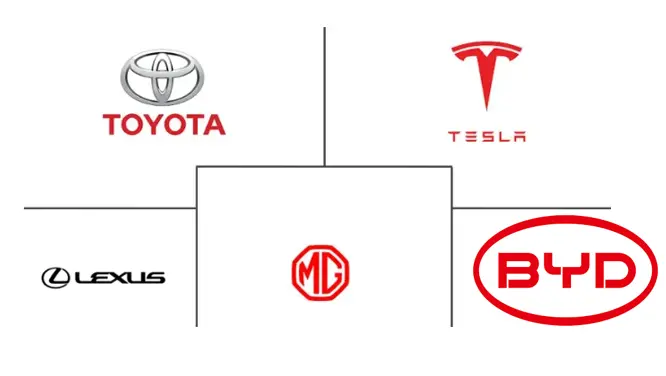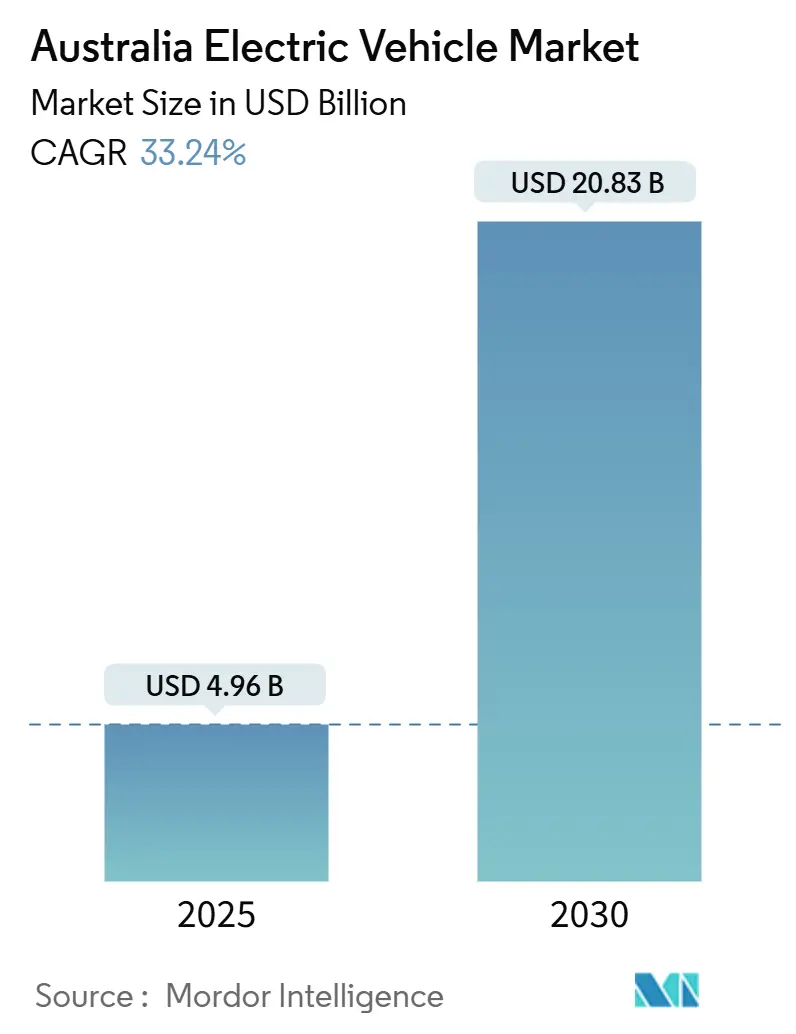
Australia Electric Vehicle Market Analysis by Mordor Intelligence
The Australia Electric Vehicle (EV) market is valued at USD 4.96 billion in 2025, and is projected to reach USD 20.83 billion by 2030, growing at a CAGR of 33.24% during 2025-2030. This transformative growth is catalyzed by implementing the New Vehicle Efficiency Standard (NVES) in 2025, compelling manufacturers to increase their EV offerings while Chinese brands rapidly gain market share through affordable models below USD 30,000. The market exhibits regional disparities, with Queensland leading growth at 30.2% CAGR (2025-2030) due to strategic infrastructure investments, while the corporate fleet segment emerges as a critical adoption catalyst, growing at 31.4% CAGR.
Key Report Takeaways
- By propulsion type, Battery Electric Vehicles secured 83.70% of Australia Electric Vehicle market share in 2024, however fuel-cell electric vehicle is estimated to expand at 45.25% by 2030.
- By vehicle type, passenger cars contributed 82.90% of 2024 EV registrations, while light commercial vehicles are forecast to expand at a brisk 34.80% CAGR during 2025-2030.
- By driving-range band, 200–400 km models dominated with 46.20% share in 2024, reflecting the sweet-spot balance between price and practicality.
- By battery chemistry, NCM/NCA packs held 57.40% share in 2024, whereas LFP chemistry is projected to post the fastest 38.50% CAGR through 2030.
- By price band, the USD 30,000–50,000 bracket delivered 55.60% of 2024 sales, but sub-USD 30,000 models are on track for the highest 37.90% CAGR to 2030.
- By ownership model, private buyers generated 73.10% of demand in 2024, while corporate fleets are anticipated to grow at 31.40% CAGR over the forecast period.
- By geography, New South Wales led with a 28.50% share in 2024, and Queensland is set to record the fastest 35.20% CAGR between 2025 and 2030.
Australia Electric Vehicle Market Trends and Insights
Drivers Impact Analysis
| Driver | (~) % Impact on CAGR Forecast | Geographic Relevance | Impact Timeline |
|---|---|---|---|
| Federal and State Incentive Schemes | +4.1% | National, strongest in QLD and ACT | Short term (≤2 years) |
| New Vehicle Efficiency Standard Creating Supply-Side Push | +3.0% | National | Medium term (2-4 years) |
| Expansion of Inter-City Fast-Charging Corridors | +3.2% | National, Eastern Seaboard focus | Medium term (2-4 years) |
| Corporate Fleet Decarbonization Commitments | +2.7% | Major urban centers | Medium term (2-4 years) |
| High Rooftop Solar Penetration Lowering Home-Charging TCO | +2.1% | Urban areas nationwide | Short term (≤2 years) |
| Entry of Sub-USD 30k Chinese Brands | +1.9% | Urban areas nationwide | Short term (≤2 years) |
| Source: Mordor Intelligence | |||
Federal & State Incentive Schemes Accelerating EV Uptake
Incentive programs continue to tilt cost-of-ownership math decisively toward plug-in choices. The fringe benefits tax exemption on eligible vehicles under AUD 89,332 can shave roughly AUD 3,000-5,000 from annual company car costs, giving fleet managers a quick payback pathway. State rebates top up those savings, and Queensland’s AUD 6,000 grant has sparked dealership promotions that bundle free home chargers. One subtle effect is that corporate procurement teams are increasingly writing tender documents that specify battery-electric models as the base case, not the alternative. As a result, the pipeline of lightly used fleet EVs, due to hitting the market around 2028, is set to lower entry prices for second-hand buyers.
Expansion of Inter-City Fast-Charging Corridors
Australia’s 1,059 public fast-charge sites now knit together the eastern seaboard, noticeably shrinking psychological range barriers during school-holiday road trips. The National EV Charging Network’s 117 additional high-rate stations promise that most highway gaps will soon shrink to under 150 km. Regional motels are already reporting weekend bookings tied to destination charging grants that cover three-quarters of hardware costs. This wave of installations also reassures apartment residents who cannot install private wall boxes, subtly broadening the addressable customer base. Commercial property owners are reacting by reserving premium parking spots for EVs, a perk that quietly reinforces perceived convenience.
Corporate Fleet Decarbonization Commitments
Board-level sustainability targets are hardening planned replacement cycles. Total cost analyses repeatedly show a 20-30 % lifetime saving for battery models once fuel, service, and resale are tallied. Consequently, some ASX-listed firms have begun negotiating multi-year supply contracts that guarantee volume, giving manufacturers confidence to stock right-hand-drive variants. An immediate side effect is higher residual-value forecasts issued by major leasing companies, which lowers lease rates for smaller businesses. Recruitment teams report that EV salary-packaging options now rank alongside flexible work policies when candidates weigh offers, indirectly pushing management to accelerate fleet turnover.
Entry of Sub-USD 30k Chinese Brands Broadening Consumer Base
Challenger brands such as BYD and MG have punctured the long-standing perception that electrics equal luxury. The Australia Electric Vehicle market share of Chinese marques jumped to over a quarter in four years, proving latent demand below USD 20,000. Established firms now respond with finance discounts rather than list-price cuts, hinting at margin protection priorities. Ownership forums reveal that many first-time buyers in this bracket previously drove decade-old second-hand petrol cars, confirming that electrification is tapping entirely new demographics. The competitive benefit for consumers manifests in standard features like vehicle-to-load sockets that once appeared only on premium badges.
Restraints Impact Analysis
| Restraint | (~) % Impact on CAGR Forecast | Geographic Relevance | Impact Timelines |
|---|---|---|---|
| Supply Shortages & Extended Waitlists | −1.4% | National | Short term (≤2 years) |
| Scarcity of EV Utes / 4×4 Models | −1.1% | Rural and regional | Medium term (2-4 years) |
| Immature Used-EV Resale Market | −0.8% | National | Short term (≤2 years) |
| Suburban Grid Constraints | −0.5% | Dense suburbs | Long term (≥4 years) |
| Source: Mordor Intelligence | |||
Supply Shortages & Extended Waitlists for Popular Models
Despite surging demand, some showrooms still quote six-month wait times for high-volume variants like the Tesla Model Y. The right-hand-drive production constraint remains a bottleneck because global factories allocate limited slots after filling European orders. Dealers occasionally charge non-refundable booking fees to manage queues, which frustrates buyers but underlines scarcity. An unintended consequence is a budding grey market where near-new vehicles list at or above new-car pricing. This mismatch directs some shoppers toward alternative brands with ready stock, effectively redistributing share without incremental industry growth.
Scarcity of EV Utes / 4×4 Models Vital for Rural Buyers
Utility vehicles form about a quarter of national new-vehicle volume, yet all-electric options are still scarce. Farmers and tradespeople hesitate to switch until a credible towing range and tray capacity arrive. The BYD Shark 6 plug-in hybrid UTE, launched in May 2025, delivers an interim bridge, but pure-battery alternatives remain at the prototype stage. Rural charging gaps compound the challenge, although state grants now prioritize regional highways. The lesson emerging is that solving commercial use-case needs may unlock a step-change in national adoption rates, given the sheer popularity of UTEs.
Segment Analysis
By Propulsion Type: BEVs Dominate While FCEVs Emerge
Battery Electric Vehicles held an 83.70% share of the Australian electric Vehicle market in 2024, demonstrating consumer trust in pure-electric drivetrains as public chargers spread. Their dominance encourages manufacturers to phase out plug-in hybrids for passenger use and focus engineering budgets on higher-density batteries. An interesting corollary is that insurers are collecting more data on battery health to refine premium models, reflecting growing asset value tied to battery packs. Plug-in hybrids maintain relevance where long-distance or towing needs persist, as a hedge for buyers worried about sparse rural chargers.
Fuel-cell Electric Vehicles post the fastest forecast CAGR at 45.25% between 2025 and 2030, even though volumes remain tiny. With AUD 80 million earmarked for refueling stations, the Hydrogen Highways program sends a clear demand signal for heavy-duty operators. Logistics firms with fixed interstate routes are already testing prototypes, hoping refueling parity with diesel stops will minimize schedule disruption. This dual-track approach suggests the Australian electric Vehicle industry may split by application, with batteries winning the light-duty segments and hydrogen carving out the heavy haulage.[1]"Driving the Nation Fund - DCCEEW," Department of Climate Change, Energy, the Environment, and Water, https://www.dcceew.gov.au
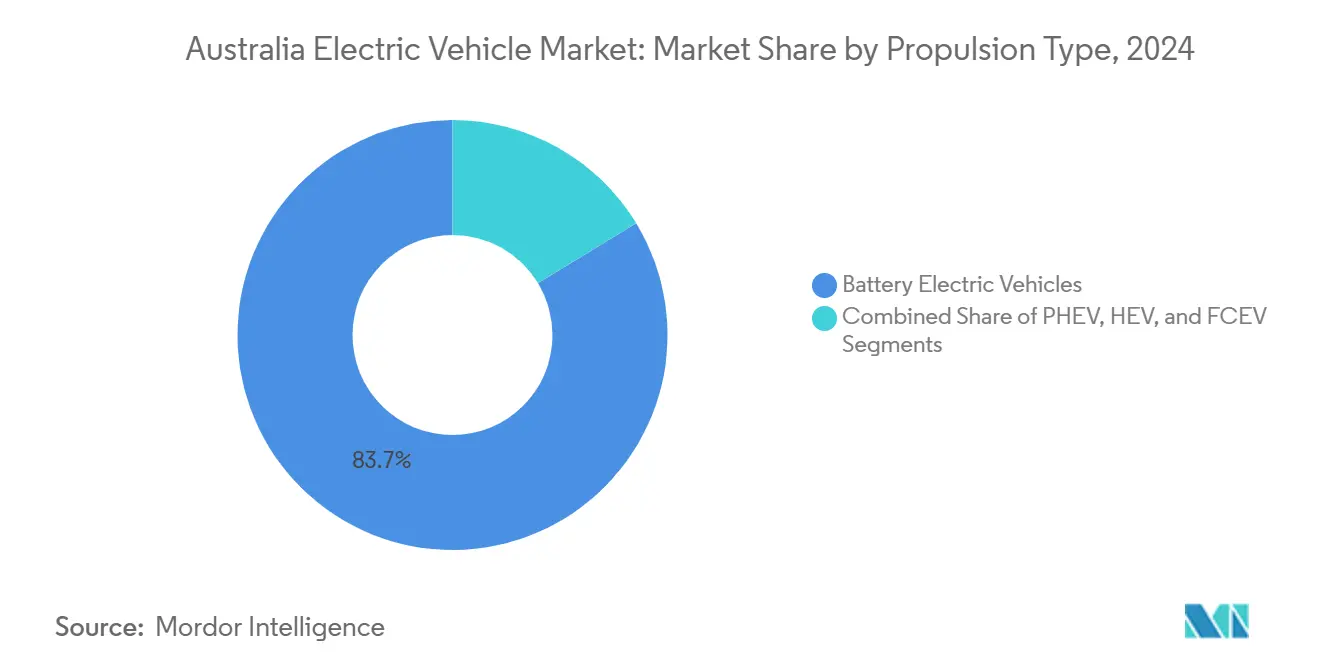
Note: Segment shares of all individual segments available upon report purchase
By Vehicle Type: Passenger Cars Lead While Commercial Segment Accelerates
Passenger cars will account for 82.90% of the Australian electric Vehicle market in 2024, thanks to early model availability and high urban densities. Within this bracket, crossover SUVs alone represent more than half of sales, mirroring long-standing national taste for higher ride heights. Families appreciate the flat-floor design that improves interior space, subtly influencing future garage designs that now factor in wider door swings. Electric sedans, while fewer, still attract tech-savvy commuters who value aerodynamic efficiency and software-driven add-ons.[1]"Driving the Nation Fund - DCCEEW," Department of Climate Change, Energy, the Environment, and Water, https://www.dcceew.gov.au
Light Commercial Vehicles show a forecast 34.80% CAGR through 2030, underscoring rising fleet procurement. Couriers and service trades note that EV vans idle silently at the kerbside, a practical benefit in noise-sensitive suburbs. Medium and heavy trucks remain experimental but see traction in municipal waste collection, where stop-start duty cycles suit regenerative braking. As commercial trial data accumulates, financing rates for these segments are likely to fall, encouraging second-tier operators to follow pioneers.
By Range: Mid-Range Dominates While Long-Range Grows Fastest
Models offering 200-400 km WLTP coverage hold 46.20% of the Australian electric Vehicle market share and hit the sweet spot for city commutes plus weekend errands. Owners often recharge once or twice a week, making daily range anxiety largely academic. The under-200 km bracket survives as cheap city runabouts or rideshare fleet cars where depot charging is routine. Notably, resale platforms show these short-range cars depreciate faster, reinforcing perceptions that mid-range is minimum viable.
The 400-600 km tier grows quickest, with a 29.70% CAGR forecast. Falling battery cost per kWh permits longer packs without breaching mainstream price bands. Buyers cite holiday travel flexibility as the decisive reason to stretch budgets for extended range. This consumer behavior implies fewer roadside charge stops per trip, which may skew utilization forecasts for ultra-fast networks.
By Battery Chemistry: NCM Leads While LFP Gains Momentum
Nickel-Cobalt-Manganese and Nickel-Cobalt-Aluminum chemistries hold 57.40% share in 2024, indicating that energy density still trumps raw cost for range-targeted models. However, LFP batteries trace a 38.50% CAGR thanks to reduced reliance on constrained metals such as cobalt and nickel. Fleet operators value LFP’s thermal stability, seeing it as a hedge against downtime caused by battery-related incidents. In turn, emerging pack designs pair LFP with cell-to-pack architecture, squeezing extra watt-hours into the same footprint.
By Price Band: Mid-Range Dominates While Entry-Level Grows Fastest
Vehicles priced between USD 30,000-50,000 command 55.60% Australia Electric Vehicle market size, reflecting the original premium skew of early offerings. Yet sub-USD 30,000 models now chart a 37.90% CAGR, signaling a democratization wave. Dealership footfall data shows that many visitors consider an EV for the first time once the on-road price dips below USD 25,000. In parallel, upper-tier models above USD 50,000 lean harder on software-enabled features like paid acceleration boosts to justify pricing.
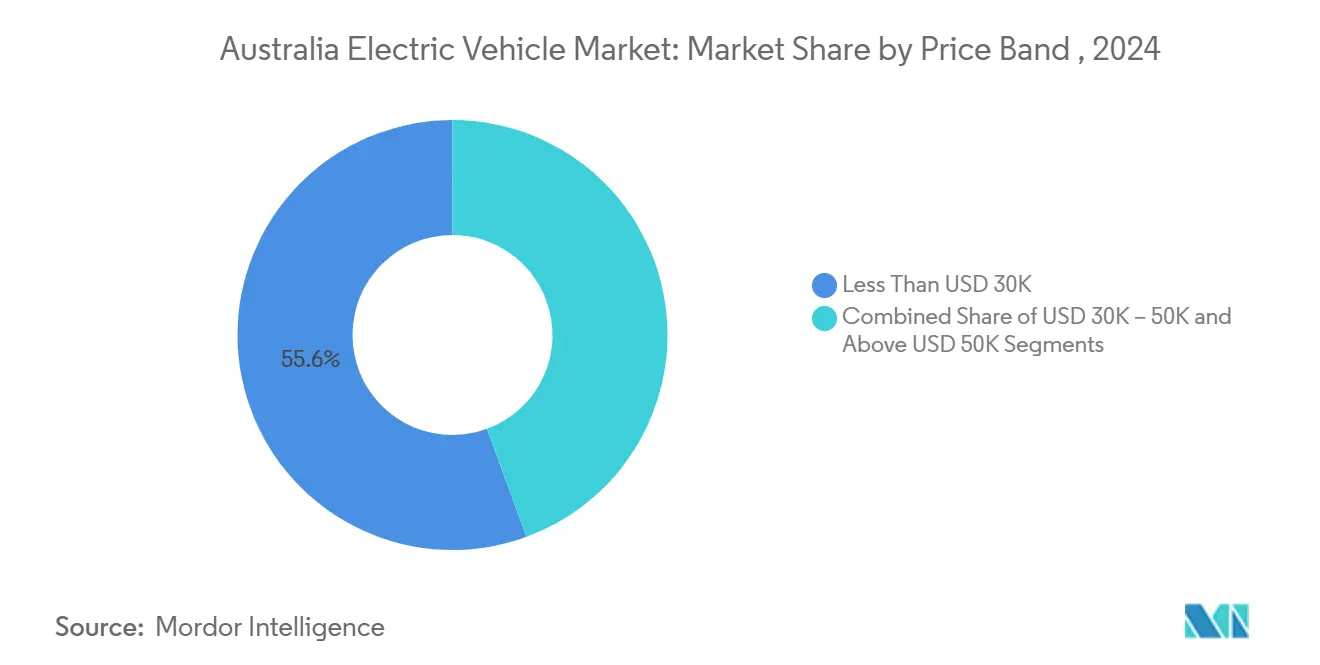
Note: Segment shares of all individual segments available upon report purchase
By Ownership Model: Private Leads While Fleet Growth Accelerates
Private buyers retain 73.10% share, confirming the cultural importance of car ownership. Charging at home aligns with typical Australian property layouts that include off-street parking, reducing infrastructure friction. Corporate fleets, poised for a 31.40% CAGR, are shifting procurement frameworks to “energy-as-a-service” contracts that wrap vehicles, chargers, and green power. Once ex-lease vehicles flood the used market in three to five years, they will broaden accessibility for lower-income households.
Geography Analysis
New South Wales leads with 28.50% of national sales, an outcome tied to both population weight and policy breadth. Sydney’s dense charger map now contains multiple 350 kW hubs, shortening queues during holiday peaks. Victoria closely follows, buoyed by government fleet targets and active local assembly discussions that aim to preserve automotive jobs in a post-internal-combustion era. A noteworthy ripple effect is the growing number of regional councils that set zero-emission fleet targets to mirror state actions, signaling policy diffusion.
Queensland exhibits the highest growth, clocking a forecast 35.20% CAGR through 2030. The Electric Superhighway’s steady extension into Far North Queensland makes long-distance coastal tourism more viable for EV owners. Brisbane’s share of state registrations reached 45 % by mid-2024, yet Gold Coast and Sunshine Coast suburbs are closing the gap, indicating decentralized adoption. As of June 2024, Queensland had registered 46,323 battery electric vehicles, with the highest concentrations in Brisbane (45%), Gold Coast (16%), and Moreton Bay (8%)[2]"Electric Vehicle Snapshot June 2024," Queensland Government, https://www.qld.gov.
The Australian Capital Territory stands out for penetration, with one in four new cars now electric[3]Elias Visontay, "EV sales reach new highs in Australia, making up nearly 10% of the car market," The Guardian, https://www.theguardian.com. Free registration and zero-interest loans lower the effective ownership cost, which even small-business operators jump into. The territory’s compact geography means range anxiety is virtually absent, allowing policy to showcase pure economic merit. Western Australia and South Australia chart steady progress, each leveraging abundant renewable energy to frame EVs as logical complements to clean grids. Meanwhile, the Northern Territory’s adoption remains limited due to sparse charging and vast travel distances, underlining infrastructure as a critical enabler.
Competitive Landscape
The market exhibits moderate concentration, dominated by Tesla, yet rapidly diversifying as BYD and MG increase their footprint. Tesla’s direct-sales model secures pricing transparency and software update agility, shaping consumer expectations across all brands. Rising Chinese competition forces faster model-year refresh cycles industry-wide, compressing traditional three-year product cadences. An emergent strategic wrinkle is platform sharing legacy brands' pool development of skateboard architectures to claw back cost parity with pure-play EV makers.
White-space opportunities remain in segments such as electric utes and long-range budget models tailored to Australian driving patterns. Local firm SEA Electric leverages low-volume adaptability to repower light trucks, highlighting a niche for domestic engineering expertise. Meanwhile, European marques collaborate on roaming agreements that let owners access third-party fast chargers seamlessly, a customer-experience angle that could blunt Tesla’s network advantage. The New Vehicle Efficiency Standard adds a regulatory incentive by penalizing high fleet emissions, effectively taxing laggard brands, and subsidizing leaders through credit trading.
Manufacturers now carefully balance headline cuts against protecting residuals, as depreciation perceptions directly affect leasing uptake. Software-based paid upgrades present a revenue hedge, allowing brands to recoup margin post-sale without headline sticker hikes. As more competitors reach volume thresholds, component suppliers signal larger purchasing contracts, which will reinforce economies of scale for early movers.The competitive dynamics are further shaped by the New Vehicle Efficiency Standard (NVES), which creates regulatory pressure for manufacturers to increase their EV offerings or face penalties, potentially accelerating model introductions beyond market-driven timelines.
Australia Electric Vehicle Industry Leaders
-
Tesla Inc.
-
MG Motor (SAIC MOTOR AUSTRALIA PTY LTD )
-
Toyota Motor Corporation
-
BYD Auto Co., Ltd.
-
Lexus Motor Corporation
- *Disclaimer: Major Players sorted in no particular order
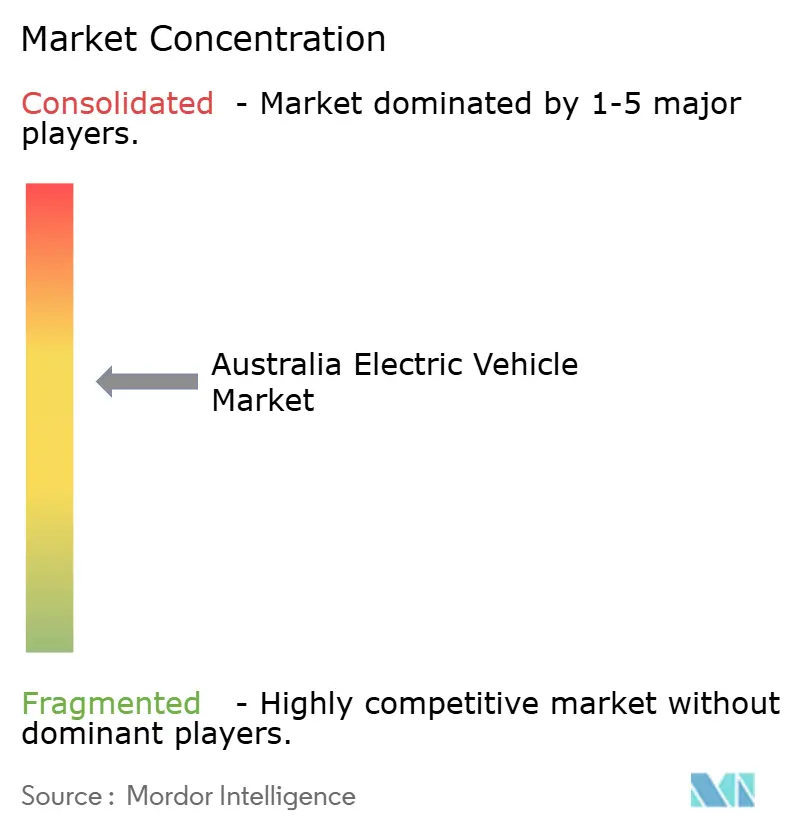
Recent Industry Developments
- May 2025: Mitsubishi has announced to launch a rebadged version of the Model B small SUV sourced from Foxtron division of Taiwan’s.
- March 2025: MG Motors has officially announced the launch of the IM brand (a joint venture between MG’s parent company, SAIC and technology company Alibaba Group) in the Australia with two electric models IM5 sedan and the IM6 SUV
- April 2025: Volkswagen launched its ID.4 mid-size SUV in Australia. The model broadens mainstream choices in the crucial family-car bracket that contributes strongly to overall market growth.
Research Methodology Framework and Report Scope
Market Definitions and Key Coverage
Our study defines the Australian electric vehicle market as the annual sales value and in-use stock of battery-electric, plug-in hybrid, hybrid, and fuel-cell passenger cars together with light, medium, and heavy commercial vehicles that are factory-built and road-legal. Values are tracked in USD and units across propulsion, range, battery chemistry, price band, ownership model, and state-level splits.
Scope Exclusion: Two-wheelers, off-highway machinery, retrofit conversions, and all charging-hardware revenue lie outside this report's scope.
Segmentation Overview
- By Propulsion Type
- Battery Electric Vehicles (BEV)
- Plug-in Hybrid Electric Vehicles (PHEV)
- Hybrid Electric Vehicles (HEV)
- Fuel-Cell Electric Vehicles (FCEV)
- By Vehicle Type
- Passenger Cars
- Light Commercial Vehicles
- Medium-Duty Commercial Vehicles
- Heavy-Duty Commercial Vehicles
- By Range
- Less than 200 km
- 200–400 km
- 400–600 km
- More than 600 km
- By Battery Chemistry
- Nickel-Cobalt-Manganese / NCA
- Lithium-Iron-Phosphate (LFP)
- Lithium-Manganese-Oxide (LMO)
- Others
- By Price Band
- Less than USD 30K
- USD 30K – 50K
- Above USD 50K
- By Ownership Model
- Private Individuals
- Corporate Fleets
- Government Fleets
- By State / Territory
- New South Wales
- Victoria
- Queensland
- Western Australia
- South Australia
- Australian Capital Territory
- Rest of Australia
Detailed Research Methodology and Data Validation
Primary Research
Mordor analysts conducted structured interviews with OEM sales heads, fleet managers, charge-point operators, and energy regulators across New South Wales, Victoria, and Queensland. These exchanges clarified transaction prices, supply wait-times, and likely compliance responses to the New Vehicle Efficiency Standard, sharpening key model assumptions.
Desk Research
We began by mapping historical registrations from open datasets such as the Federal Chamber of Automotive Industries' VFACTS, the Australian Bureau of Statistics motor-vehicle census, and the Department of Infrastructure's Green Vehicle Guide. We then linked them to policy levers drawn from Commonwealth and state gazettes. Charger density and grid headroom were traced through Australian Energy Regulator filings, ARENA dashboards, and Electric Vehicle Council scorecards. Company filings, investor decks, and D&B Hoovers supplied pricing and margin clues, while IEA Global EV Outlook, UN Comtrade, and Volza shipment codes anchored global context. The sources named are illustrative; many further materials supported data gathering and verification.
Market-Sizing & Forecasting
A blended top-down and bottom-up approach was applied. National registration totals were projected through a penetration-rate pool linked to battery cost curves, fast-charger rollout, fleet electrification targets, and NVES penalty trajectories. These were then reconciled with sampled dealer ASP × volume roll-ups. Core variables included quarterly BEV share of new sales, average battery-pack price per kWh, connectors per 100 km of highway, corporate fleet electrification pledges, and state rebate envelopes. Forecasts to 2030 rely on multivariate regression with ARIMA overlays, and supplier roll-ups bridge residual data gaps.
Data Validation & Update Cycle
Outputs pass anomaly checks against import statistics and electricity-demand patterns before senior review. We refresh the model annually and trigger interim updates when policy or supply shocks materially shift any driver. Every delivery is preceded by a fresh validation pass.
Why Mordor's Australia Electric Vehicle Baseline Commands Reliability
Published estimates often diverge because researchers mix vehicle classes, bundle ancillary revenue, or apply different currency years. By limiting scope to road-registered cars and commercial vehicles, valuing everything in constant 2024 dollars, and revisiting inputs each year, Mordor delivers a steadier compass for decision-makers.
Benchmark comparison
| Market Size | Anonymized source | Primary gap driver |
|---|---|---|
| USD 4.96 B (2025) | Mordor Intelligence | - |
| USD 8.57 B (2024) | Regional Consultancy A | Includes micro-mobility and aftermarket parts; no inflation adjustment |
| USD 16.20 B (2024) | Global Consultancy B | Combines Australia & NZ and folds charger revenue |
The comparison shows that once geography, vehicle basket, and ancillary revenue are harmonized, Mordor's disciplined, variable-based approach yields a transparent baseline clients can replicate and stress-test with confidence.
Key Questions Answered in the Report
Which state currently registers the fastest EV adoption growth?
Queensland shows the quickest climb, backed by robust purchase rebates and the expanding Electric Superhighway.
How do current tax incentives lower fleet electrification costs?
Fringe benefits tax exemptions on eligible models under AUD 89,332 can save businesses around AUD 3,000-5,000 in yearly operating costs per vehicle.
Which price segment is growing the fastest in the Australian electric Vehicle industry?
The less than USD 30,000 bracket grows the quickest as Chinese brands introduce competitively priced models that appeal to mainstream buyers.
What charging type dominates daily Australian EV use?
AC Level 1/2 home and workplace charging dominates, representing more than two-thirds of charging events owing to convenient overnight top-ups.
Page last updated on:
